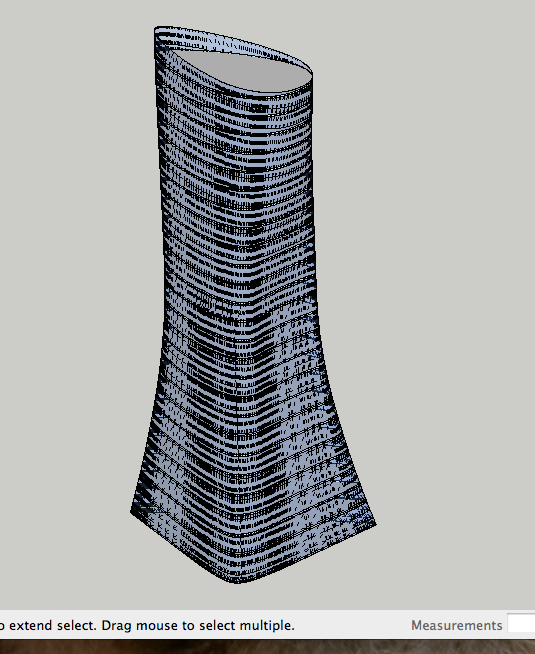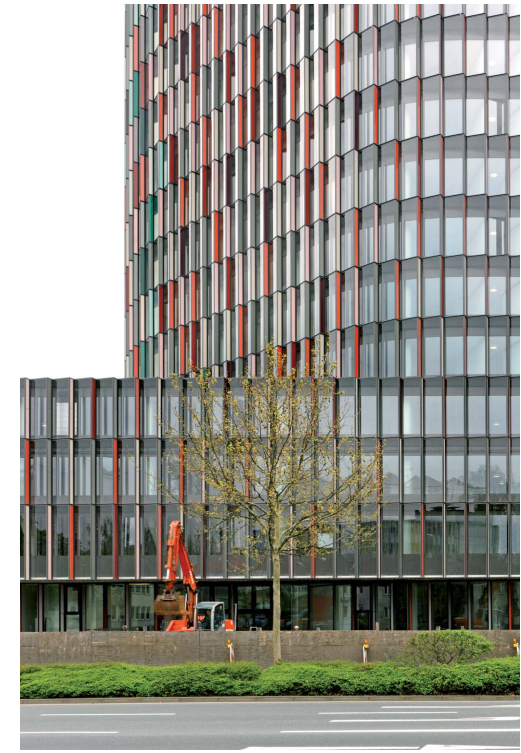Help needed with organic modelling
-
Non manifold means it has internal geometry. Use Thom's Solid Inspector plugin to track it down.
-
Hi, Rico:
I can tell you what I think it means, and maybe you can figure out how to get around it.
In modeling, and/or 3d printing, manifold means a fully closed volume. "Absolutely" no gaps, even tiny ones. People use the analogy of "watertight". -
Thanks guys, Thom's Solid Inspector did the trick, and managed to slice up the shape. Now comes the tricky part....
for each of the layers im going to have to model window mullions of some sort, is there an easy way to do this?
I would also need to give the skin some thickness, is there any sort of offset plugin that works with curved walls?Cheers
Rico
-
Theoretically, any form can be offset by a tool like Fredo6's JointPushPull set. However, based on the images above, you may have some difficulty because of the complexity. With a little bit of planning for setting up central reference points you may want to use either the Scale Tool or FredoScale--both act similarly but Fredo's enhances certain steps. If you group and scale down a percentage that would represent the "wall" thickness, keep in mind you are "offsetting" the top and bottom by the same factor. You will probably have to do some knitting.
All that said, there may be some jaw dropping tool out there that I am not aware of. -
If you used the Artisan method then you could use Joint Push Pull on the proxy to add thickness before subdividing.
Using the Curviloft method you can offset each segment to create two sets of profiles that will give you thickness.
-
ok sweet, thanks alot guys, anyone got ideas about how to cut out holes for the windows?
-
There are so many options, it's difficult to offer advice without seeing exactly what you have in mind.
-
That's a really elegant solution

The only downside is that I have feeling that Windowizer will only work on single planes (I might be wrong).
-
Maybe like this ?
"Multiple Face Offset" By Remus
Windowizer(3 free or 4) By Rick Wilson @Smustard ("Frame Inset")
Windowizer take any form of windows in multiple selection!
Selection Only faces by Selection Toys by Thomthom

Invert Selection by TIG
-
Just tried to use windowizer but no luck, thing it might have something to do with the insane amount of geometry in the thing.....


The windows id like to achieve would ideally like to be something like this http://www.archiscene.net/wp-content/uploads/2012/01/Garden-Ribbons-by-ShaGa-Studio02.jpg or this

Thanks again guys!
-
For that kind of thing I would create a window component and then try using Component Stringer to add them to each floor.
-
ok thats great, im trying that now. I've intersected the overall form manually then grouped the shape and left the intersection lines which i then welded. When I apply the component stringer the components are scattered randomly due to the geometry of the line, is there any way to smooth the line and then divide it into equal lengths of geometry so that the components get scattered equally?
-
I've only used the plugin for basic stuff so I'm not sure. I'll have a look when I'm back in the office tomorrow.
-
great stuff, thanks alot
-
I'm not sure what your intended final output of this model is, but could you just use texturing for the windows. I'm just thinking with the number of components you need for windows its going to make the model hard to work with.
-
I did think about texturing, but i will be later using the model to generate floorplans, elevations and sections so really need all of the geometry to be there and to be accurate.
-
The only suggestion I can come up with is redrawing each floor profile with a set number of evenly sized segments. You should then be able to do something like this:

-
This might not be the best answer, since we are on SketchUcation and all, but have you considered another software package? What you are doing would be much easier in Rhino with Grasshopper, Revit, Bentley GC, or something like that. You could always create the mass and populate it with windows, then bring it back into SketchUp for your other drawings and adding other stuff.
-
@o0rico0o said:
I did think about texturing, but i will be later using the model to generate floorplans, elevations and sections so really need all of the geometry to be there and to be accurate.
Bad idea... If you want a total architectural model, you have to use an architectural CAD or BIM tool. Sketchup is not. SU is a geometrical modeler, so you can imagine use it for elevations but not for complete sections or floorplans in this kind of complex project... Ok, you can do it, but it's not the easiest tool and not the most flexible, as you can make an total architectural model sculpting in a bloc of wood but is better make it with cardboard.
So, my opinion, use SU to make the external model with floors (and with this kind of shape, you better use a NURBS tool like free 123D), use it for elevations, and extract sections and plans and draw all details in a 2D CAD if you don't want to use BIM tool. -
I found this thread to be a really usefull tutorial.
Advertisement








